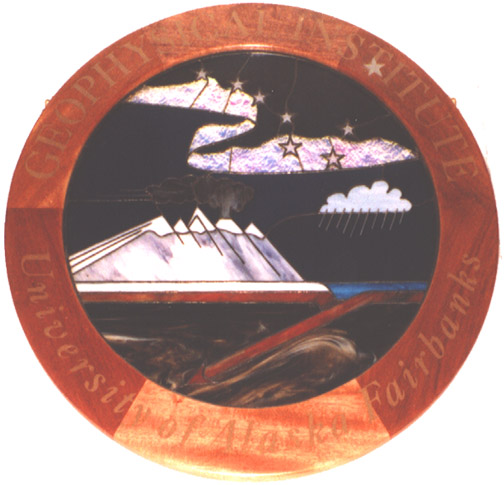A Gift from the Geophysical Institute to its Director,
Dr. Syun-Ichi Akasofu,
celebrating his 40 years of scientific excellence at the Geophysical Institute, University of Alaska, Fairbanks




Alternate views in different lighting




Notes about the glass panel excerpted from the information provided with it:
- Unlike most stained glass, this 24" diameter (before framing) panel is totally lead-free, so it poses no health hazard and is environmentally friendly. It was made with a eutectic alloy of Tin, Copper and Silver which is stronger, though more difficult to work with, than the usual leaded solders.
- The Dichroic glass used for the aurora is technologically special. Austin Thin Films makes it by vacuum depositing multiple thin layers of exotic materials at high temperature onto clear Uroboros glass. This gives it the optical filtering properties of transmitting and reflecting different wavelengths as well as transmitting a third off-axis color when viewed at a 45 degree angle. The coating on the front of the Dichroic aurora glass is extremely thin and easily damaged by chemicals or abrasion. Clean it only with a soft cloth and mild glass cleaner.
- The straight lines of the rain, wind, mountains and glaciers are overlaid on top of the glass and only connected at one end. This makes them especially fragile and difficult to clean around as they may be easily bent causing damage to the solder bead they are attached to.
- The 31" diameter frame is hand crafted from mahogany and left in its natural color. It is finished with water-based polyurethane that protects it from ultraviolet light, but is not suitable for exposure to outdoor weather. It is quite durable and washable.
- The letters are inlayed into the mahogany, not painted on, so they are extremely durable. They are made using a modern technique known as "cold cast bronze" which is becoming a popular sculpture method. The letters were carved into the wood using a computer controlled router and filled with a mixture of bronze powder and urethane resin. They were then sanded and polished flush with the wood surface. The star was then routed out and filled with aluminum instead of bronze.
- The design of the GI logo is largely attributed to Dr. David Stone, though it is my understanding that there have been several other contributors. I have taken the liberty to alter the design in order to render it in glass as well as significantly depart from the traditional coloration.
- This stained glass panel was hand crafted in Ester, Alaska by Cole & Nancy Sonafrank and presented, on behalf of the entire Geophysical Institute, in gratitude and profound respect to Dr. Akasofu on July 1st, 1999. It currently hangs in the breezeway connecting the Geophysical Institute with the new International Arctic Research Center of which Dr. Akasofu is the founding Director.